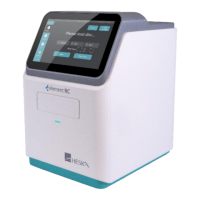__________________________________________________________________________
Vers. 20210510ENG Page 6
1.3 element RC Analyzer Use
Follow the instructions below before operation:
❖ Please check the analyzer contents and packing list.
❖ Please read documents included with the analyzer.
The analyzer should be protected from working in humid and corrosive environments. Do not
use flammable or explosive gas around the equipment.
Do not remove covers or other parts that are secured with screws to avoid electrical shock
that may result from exposure to hazardous voltage or injury from moving parts.
Wear protective gloves, lab coat and safety goggles.
It is the user’s responsibility to provide a compatible electromagnetic working environment to
ensure the analyzer will perform as intended.
The analyzer complies with the requirement of equipment emission and immunity in GB/T
18268. The analyzer is designed and tested according to Class A equipment in GB 4824.
Do not use this analyzer near strong radiation sources (such as unshielded FR sources), as
this may interfere with the normal operation of the analyzer.
Avoid installation locations where water may splash on the equipment.
Plug the power cable into an outlet with a grounding receptacle. Electrical shock may occur if
the equipment is not grounded to a protective earth.
Make sure that all cables have been properly connected.
When handling samples (blood) and cleaning or maintaining the analyzer, always follow the
biohazard procedures in accordance with the sample handling rules of your facility.
Use proper protective gear (gloves, lab coat, safety goggles).
Used consumables such as rotors, tips, tubes and cloths used to clean the equipment are
infectious waste. Process this waste in compliance with any applicable local, state or country
regulations.

